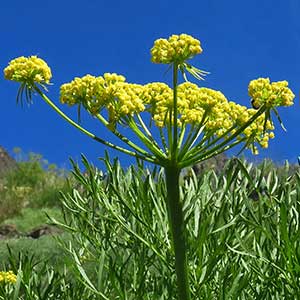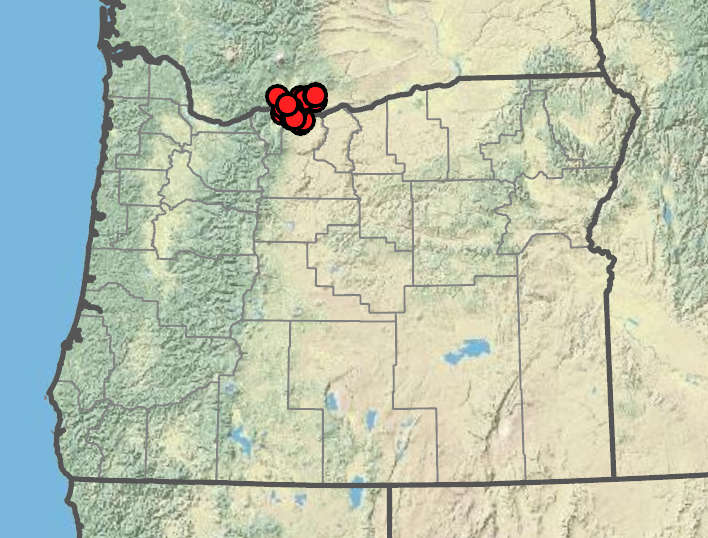Lomatium suksdorfii
Lomatium rollinsii
Suksdorf's desert parsley, Suksdorf's lomatium
Rollins' biscuitroot, Rollins' desert parsley
stout and thickened, elongate taproots or stout and irregularly thickened taproots.
elongate and slender taproots or globose or irregularly thickened tubers with an elongate upper section < 2 cm, tapered abruptly at base into an elongate and slender taproot.
2–3-branched or multicipital;
basal leaf sheaths from previous years weathering into a fibrous thatch at or below ground level;
peduncles persistent in thatch as gray stalks.
simple;
basal leaf sheaths from previous years absent or weathering into a few fibers or a sparsely chartaceous thatch at base of stem.
9–20 dm; stout but not inflated; pseudoscapes absent.
10–30 cm; pseudoscapes absent.
glabrous;
primary leaflets pinnate, 3–7 secondary leaflet pairs along each rachis (mature basal leaves may have more pairs; but these are not usually collected for specimens);
laterals less than half of central primary in length;
secondaries pinnate or pinnatifid;
tertiaries entire or pinnatifid (2–4-lobed), ultimate apical lobes linear, narrowly oblong, narrowly elliptic, 10–30 × 1–3 mm;
tips acute, acuminate, or subacute, mucronulate or not.
glabrous, glabrate or sparsely puberulent or pubescent;
primary leaflets pinnate, 2–6 secondary leaflet pairs along each rachis;
laterals less than half central primary in length;
secondaries entire, pinnate, or pinnatifid (3–5-lobed);
tertiaries absent or entire, ultimate apical lobes linear, narrowly elliptic, or narrowly oblong, 5–15 × 0.5–2 mm;
tips acute, subacute, or rounded.
1–3, similar to basal.
1–3, similar to basal.
peduncles 1–4 (more in robust plants), ascending or erect; stout but not inflated, 30–80+ cm;
involucral bracts 0;
rays 8–20, 3–11 cm, glabrous;
involucel bractlets 4–6, linear or lanceolate, 5–10 × 0.3–1 mm, unlobed or 2-lobed;
margins narrowly scarious or not;
umbellets 10–40-flowered;
pedicels 6–17 mm.
peduncles 1–4, ascending or erect, 8–20 cm, glabrate below or sparsely to moderately pubescent or puberulent above;
involucral bracts 0;
rays 1–6, 1–5 cm, glabrate or sparsely puberulent;
involucel bractlets 0–6, linear, 2–4 × 0.2–0.5 mm;
margins scarious;
umbellets 7–15-flowered;
pedicels 5–15 mm.
petals yellow;
anthers ochroleucous or yellow.
petals ochroleucous or yellow;
anthers ochroleucous or yellow.
oblong, 15–25 mm, glabrous;
body 4–6 mm wide;
wings 1–3 mm; thin;
vittae 1–4 in intervals, 2 on commissure.
elliptic, oblong, 6–8 mm, glabrous;
body 2–3 mm wide;
wings 0.5–1 mm; thin;
vittae 1–2 in intervals, 4 on commissure.
=22.
Lomatium suksdorfii
Lomatium rollinsii
Gravelly or rocky slopes, talus, rock outcrops, scrubland, oak forests, conifer forests. Flowering Apr–Jun. 50–100 m. Col, ECas. WA. Native.
Open gravelly sites, rocky flats, grasslands, scrublands, igneous-derived substrates. Flowering Mar–May. 200–500 m. BW. ID, WA. Native.
Lomatium leptocarpum and L. triternatum specimens, in early flower, are often misidentified as this taxon when poorly collected (i.e., shriveled, poorly pressed, or leaf and flower clippings).
Jason Alexander
Jason Alexander





